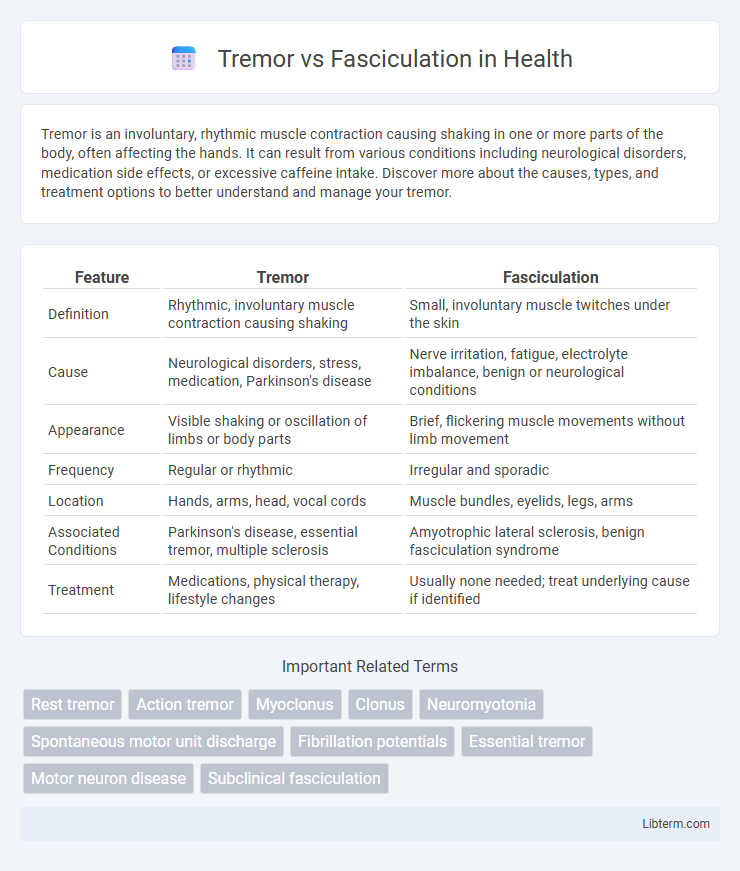Tremor is an involuntary, rhythmic muscle contraction causing shaking in one or more parts of the body, often affecting the hands. It can result from various conditions including neurological disorders, medication side effects, or excessive caffeine intake. Discover more about the causes, types, and treatment options to better understand and manage your tremor.
Table of Comparison
| Feature | Tremor | Fasciculation |
|---|---|---|
| Definition | Rhythmic, involuntary muscle contraction causing shaking | Small, involuntary muscle twitches under the skin |
| Cause | Neurological disorders, stress, medication, Parkinson's disease | Nerve irritation, fatigue, electrolyte imbalance, benign or neurological conditions |
| Appearance | Visible shaking or oscillation of limbs or body parts | Brief, flickering muscle movements without limb movement |
| Frequency | Regular or rhythmic | Irregular and sporadic |
| Location | Hands, arms, head, vocal cords | Muscle bundles, eyelids, legs, arms |
| Associated Conditions | Parkinson's disease, essential tremor, multiple sclerosis | Amyotrophic lateral sclerosis, benign fasciculation syndrome |
| Treatment | Medications, physical therapy, lifestyle changes | Usually none needed; treat underlying cause if identified |
Introduction to Tremor and Fasciculation
Tremor is an involuntary, rhythmic muscle contraction leading to shaking movements in one or more parts of the body, commonly seen in conditions such as Parkinson's disease and essential tremor. Fasciculations are spontaneous, involuntary muscle fiber twitches that occur under the skin without causing movement of the limb, often associated with nerve irritation or motor neuron disease like amyotrophic lateral sclerosis (ALS). While both involve muscle activity, tremors produce visible oscillations, whereas fasciculations are brief, localized muscle fiber contractions.
Defining Tremor: Key Features
Tremor is an involuntary, rhythmic muscle contraction causing shaking movements in one or more parts of the body, often classified based on its frequency, amplitude, and context such as rest, action, or postural tremor. Key features include periodic oscillations with a consistent frequency range typically between 4 to 12 Hz, distinguishable from fasciculations which are irregular, spontaneous muscle twitches without rhythmicity. Tremors commonly affect the hands, head, or voice and are symptomatic of neurological disorders like Parkinson's disease or essential tremor.
Understanding Fasciculation: What It Means
Fasciculation refers to involuntary muscle fiber contractions causing small, localized twitches visible under the skin, typically linked to nerve irritation or motor neuron disorders. Unlike tremors, which are rhythmic movements affecting larger muscle groups, fasciculations tend to be irregular and sporadic, often associated with conditions like amyotrophic lateral sclerosis (ALS) or benign fasciculation syndrome. Understanding fasciculations involves recognizing their role as potential indicators of underlying neurological issues requiring medical evaluation.
Causes of Tremor
Tremors are primarily caused by neurological disorders such as Parkinson's disease, essential tremor, or multiple sclerosis, which disrupt normal motor control. Other causes include metabolic imbalances, medication side effects, and anxiety-induced physiological changes. Unlike fasciculations, which are localized muscle twitches due to nerve irritation or muscle fatigue, tremors result from rhythmic, involuntary muscle contractions often linked to central nervous system abnormalities.
Causes of Fasciculation
Fasciculations are involuntary muscle twitches often caused by nerve irritation, muscle fatigue, electrolyte imbalances, or neurological disorders such as amyotrophic lateral sclerosis (ALS) and peripheral neuropathy. Unlike tremors, which involve rhythmic oscillations linked to movement disorders like Parkinson's disease, fasciculations result from spontaneous firing of motor units within a muscle. Common triggers include stress, caffeine intake, and medications that affect nerve or muscle function.
Clinical Differences Between Tremor and Fasciculation
Tremor presents as rhythmic, oscillatory movements typically involving large muscle groups, often observed in conditions such as Parkinson's disease and essential tremor. Fasciculations are involuntary, spontaneous muscle fiber contractions seen as brief, fine twitches beneath the skin, commonly linked to motor neuron disorders like amyotrophic lateral sclerosis. Clinically, tremors are persistent and rhythmic, whereas fasciculations are irregular, focal, and not associated with voluntary movement control.
Diagnostic Approaches
Tremor and fasciculation are distinguished through specific diagnostic approaches, with electromyography (EMG) playing a crucial role in identifying muscle activity patterns; tremors exhibit rhythmic, oscillatory movements, whereas fasciculations present as irregular, spontaneous muscle fiber twitches. Clinical examination assesses movement characteristics and triggers, while imaging techniques like MRI may be utilized to exclude underlying neurological disorders. Accurate differentiation aids in diagnosing conditions such as Parkinson's disease for tremors and amyotrophic lateral sclerosis (ALS) for fasciculations.
Associated Medical Conditions
Tremors are commonly associated with Parkinson's disease, multiple sclerosis, and essential tremor, reflecting underlying neurological dysfunction. Fasciculations often indicate motor neuron diseases such as amyotrophic lateral sclerosis (ALS) or benign conditions like benign fasciculation syndrome. Differentiating between these involuntary movements is crucial for accurate diagnosis and management of the associated medical conditions.
Treatment and Management Strategies
Treatment and management of tremors typically involve medications such as beta-blockers, anticonvulsants, or benzodiazepines to reduce symptom severity, alongside physical therapy to improve motor control. Fasciculations, often caused by benign conditions, generally require addressing underlying issues like electrolyte imbalances or nerve irritation, with medications prescribed only if linked to neurological disorders such as ALS. Advanced management for both conditions may include botulinum toxin injections or surgical interventions like deep brain stimulation for refractory tremors.
When to Seek Medical Advice
Seek medical advice if tremors or fasciculations are persistent, worsening, or accompanied by muscle weakness, numbness, or coordination difficulties. Tremors linked to Parkinson's disease, essential tremor, or multiple sclerosis require professional evaluation to determine appropriate treatment. Fasciculations that occur with muscle atrophy or fatigue may indicate motor neuron disease and warrant prompt neurological consultation.
Tremor Infographic

 libterm.com
libterm.com